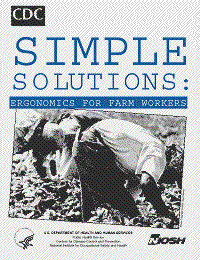|
Smaller Picking Tub:
| Problem: |
One Solution: |
| In hand harvest of wine grapes, the tubs
used are heavy when full and, thus, can
contribute to back and knee injuries. |
Use a smaller, lighter tub (on the right) that
has add-on grips and weighs an average
46 pounds when full. |
  |
 |
Workers cut grapes directly into plastic tubs
and then carry the tubs to trailer-mounted
gondolas. When full, the tubs weigh an
average of 57 pounds. |
The lower weight is easier on the back,
knees, and arms. The narrower width positions
the tub’s center of gravity closer to the
worker, which reduces stress on the back. |
Worker must stoop, grip, lift, carry, and
dump up to 20 times per hour, not including
the stooping, gripping, and relocating of the
tub as the worker moves down the row of
vines. |
Lighter weight and smoother bottom surface
reduce the sideways forces on the
knees when pushing the tub down the row. |
A side-sweeping motion of the leg is often
used to move the tub along the vine until it
is about half full, at which point the tub is
lifted. |
Better handles reduce pressure points on
the fingers. |
For dumping into the gondola, the full tub is
often lifted above the head. |
Can have minor negative impact on production,
but has gained approval of piecerate
workers. |
Picking Tub
How Much Difference Does the
Smaller Tub Make?
The smaller tub was tested at several vineyards
in a NIOSH-funded ergonomics study in
California's Napa and Sonoma counties.
After the harvest season, workers reported pain
and symptoms of injury that were only one-fifth of
what they were with the large tub. Reduction of
pain symptoms indicates a lower risk for future
chronic injury or cumulative trauma disorder such
as nagging back or joint pain.
How Does the Smaller Tub Affect
Productivity?
Only negligibly. In a three-year field trial, the
smaller tub resulted in a 2% reduction in pounds
of grapes delivered to the gondola per day.
Neither managers nor workers perceived the
reduction in the field.
The reduction in productivity was not as much as
might be expected, given that the two tubs are
significantly different in size. This was apparently
because workers using the small tub were less
tired throughout the day and made 20 more carries
per shift.
Despite making more carries, workers using the
small tubs used less energy and had lower heart
rates. They liked the smaller tubs better, reporting
that they were less tired at day's end.
Here is the best "proof" that the smaller tub is
better for workers: Workers on piece rate, who
usually are eager for maximum productivity, preferred
the smaller tub.
Where Can I Get a Smaller Tub?
The tub used in the study was a LEWISystems
SN2414-8 stack/nest tub by Menasha
Corporation of Watertown, Wisconsin, 800-558-
9563. Cost is about $13 each.
The SN2414-8 is two inches narrower and over
two pounds lighter than the old tub. Ask your
existing supplier for a smaller tub that is similar to
the one used in the study; you may find good
alternatives.
How Do I Make the Add-On Grips?
The add-on grips are simple to make using 1/2"
PVC pipe (Schedule 40), a saw (preferably a
band saw), and a jig such as suggested in the
diagram below. The jig will cost about $75 to
have made.
Cut the PVC pipe to 5" lengths and cut an
approximately 1/32"-wide slit lengthwise in the
PVC using the jig. Use a slotted screwdriver to
help slide the PVC over the edge of the tub's
existing grip.
Contact Information:
This Tip Sheet was produced by the University of
California Agricultural Ergonomics Research
Center under a grant from the National Institute
for Occupational Safety and Health.
UC Ag Ergonomics Research Center, Bio & Ag
Engineering, UC Davis, One Shields Avenue,
Davis, CA 95616-5294.
Or visit http://ag-ergo.ucdavis.edu.
|


